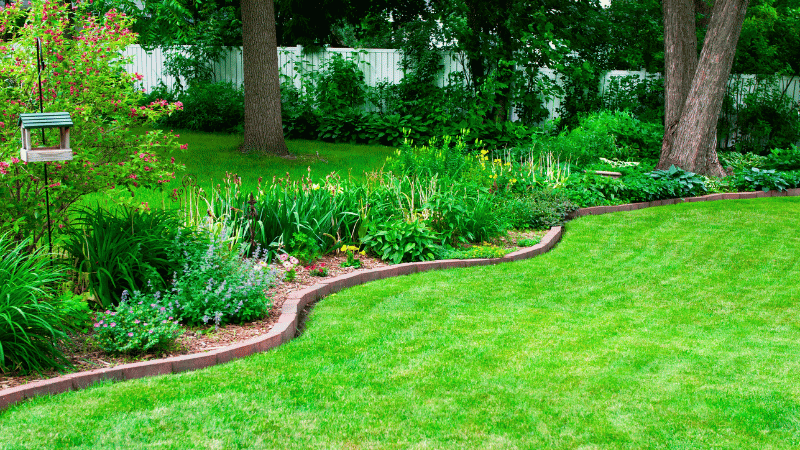Imagine a beautiful, lush lawn that’s the envy of your neighborhood, but at what cost to your health and the environment? While a well-maintained lawn and pest-free yard can enhance the beauty of your property, it’s essential to consider the implications of using pesticides and chemicals. These substances can have significant effects on not only the environment but also the health of your guests and loved ones. Responsible lawn and pest care practices are key to maintaining a safe and inviting outdoor space. Here’s how to make informed decisions and adopt practices that promote both a beautiful yard and a healthier environment.
The Impact of Pesticides and Chemicals
Pesticides and chemicals are commonly used to manage pests and maintain a pristine lawn. While they can be effective, their use comes with several concerns:
Environmental Consequences
● Soil Health: Chemicals can disrupt the balance of soil microorganisms essential for healthy plant growth. This can lead to decreased soil fertility and long-term damage to the ecosystem.
● Water Contamination: Pesticides and fertilizers can run off into waterways, potentially contaminating drinking water sources and harming aquatic life.
● Biodiversity: Excessive use of chemicals can negatively impact beneficial insects, birds, and other wildlife that contribute to a balanced ecosystem.
Health Risks
● Indoor Air Quality: Chemicals can be tracked indoors on shoes and clothing, potentially affecting indoor air quality and contributing to health concerns.
● Human Health: Exposure to pesticides, herbicides, insecticides and fungicides has been linked to various health issues, including respiratory problems, skin irritation, and more severe conditions like neurological disorders and cancer. Children and pets are particularly vulnerable due to their higher levels of exposure and sensitivity. Furthermore, these chemicals can cause:
a. Acute Poisoning
- Exposure: Inhalation, ingestion, or skin contact with pesticides can lead to acute poisoning. Symptoms may include nausea, vomiting, dizziness, headaches, respiratory issues, and, in severe cases, convulsions, or death.
- Vulnerable Populations: Children, pregnant women, and individuals with compromised immune systems are particularly at risk. Children are more susceptible because of their smaller body size, higher metabolic rate, and developing organs.
b. Chronic Health Effects
- Cancer: Prolonged exposure to certain pesticides has been linked to various cancers, including non-Hodgkin lymphoma, leukemia, and prostate cancer. For example, glyphosate, a common herbicide, has been classified as a probable human carcinogen by the International Agency for Research on Cancer (IARC).
- Endocrine Disruption: Some pesticides act as endocrine disruptors, interfering with hormone function. This can lead to reproductive issues, developmental problems, and an increased risk of hormone-related cancers.
- Neurological Effects: Chronic exposure to certain pesticides, such as organophosphates, has been associated with neurological problems, including Parkinson’s disease, cognitive deficits, and developmental delays in children.
- Respiratory Issues: Inhalation of pesticide residues can lead to respiratory problems, including asthma and chronic obstructive pulmonary disease (COPD). Agricultural workers and residents near treated fields are particularly vulnerable.
Responsible Lawn and Pest Care Practices
Adopting responsible lawn and pest care practices can help mitigate these risks and create a safer environment for everyone. Here’s how to approach lawn and pest care more sustainably:
1. Integrated Pest Management (IPM)
IPM is a holistic approach that combines various methods to control pests while minimizing harm to people and the environment. Key components include:
● Monitoring: Regularly inspect your yard for signs of pests and assess the extent of the problem before taking action.
● Prevention: Implement preventive measures, such as maintaining healthy plants and proper lawn care, to reduce the likelihood of pest problems.
● Non-Chemical Controls: Use physical barriers, traps and natural predators to manage pests. For example, ladybugs can help control aphid populations.
● Targeted Application: If chemical treatments are necessary, apply them selectively and follow all safety instructions to minimize impact.
2. Natural and Organic Alternatives
Consider using natural or organic products that are less harmful to the environment and human health. Options include:
● Essential Oils:
- Peppermint Oil: Acts as a natural insect repellent for ants, aphids, and beetles. Diluted peppermint oil can be sprayed on plants or around the home.
- Cedarwood Oil: Used to repel moths, ants, fleas, and ticks. It can be applied to garden areas or used in the home to keep pests away.
● Pyrethrin: Derived from chrysanthemum flowers, pyrethrin is a natural insecticide that targets a wide variety of pests. It breaks down quickly in the environment but should be used carefully, as it can be toxic to bees and aquatic life.
● Beneficial Insects: Introduce natural predators like ladybugs, lacewings, and parasitic wasps that feed on common garden pests such as aphids, caterpillars, and whiteflies.
● Nematodes: Beneficial nematodes are microscopic worms that target soil-dwelling pests like grubs and root weevils without harming plants or beneficial organisms.
● Bt (Bacillus thuringiensis): A naturally occurring bacterium that is toxic to specific insects like caterpillars but safe for humans, animals, and beneficial insects. It is commonly used in organic farming.
● DIY Pesticides:
- Neem Oil Spray
- Ingredients: Neem oil, water, mild liquid soap (like castile soap).
- How to Make: Mix 2 tablespoons of neem oil with 1 teaspoon of mild liquid soap in 1 gallon of water. Stir well.
- How to Use: Spray on affected plants every week, especially targeting the undersides of leaves. Neem oil is effective against a wide range of pests like aphids, whiteflies, and spider mites.
- Why It Works: Neem oil disrupts the life cycle of insects, preventing them from feeding, reproducing, or developing properly.
- Garlic and Chili Spray
- Ingredients: 10-15 cloves of garlic, 2 hot peppers (or 1 tablespoon of chili powder), 1 quart of water, 1 teaspoon of mild soap.
- How to Make: Blend garlic and peppers with water, then strain the mixture. Add the soap and mix well.
- How to Use: Spray on plants to deter insects like aphids, caterpillars, and beetles. Apply in the early morning or late afternoon to avoid burning the plants in direct sunlight.
- Why It Works: The strong smell and taste of garlic and chili repel many insects.
- Diatomaceous Earth
- Ingredients: Food-grade diatomaceous earth.
- How to Use: Dust plants and the surrounding soil lightly with diatomaceous earth. Reapply after rain or heavy watering.
- Why It Works: Diatomaceous earth is made from fossilized algae and has sharp edges that damage the exoskeletons of insects, causing them to dehydrate and die.
- Insecticidal Soap Spray
- Ingredients: Mild liquid soap (like castile soap), water.
- How to Make: Mix 2-3 tablespoons of mild soap in 1 gallon of water.
- How to Use: Spray directly on soft-bodied insects like aphids, mealybugs, and spider mites. Avoid using it during the hottest part of the day to prevent plant damage.
- Why It Works: The soap dissolves the protective outer layer of insects, leading to dehydration.
● DIY Herbicides:
- Vinegar Herbicide
- Ingredients: White vinegar, salt, liquid dish soap.
- How to Make: Mix 1 gallon of white vinegar with 1 cup of salt and 1 tablespoon of liquid dish soap. Stir until the salt dissolves.
- How to Use: Spray directly onto weeds on a sunny day. Avoid spraying desirable plants as it can kill them too.
- Why It Works: The acetic acid in vinegar draws moisture out of the weeds, while the salt further dehydrates them. The dish soap helps the solution stick to the leaves.
- Boiling Water
- Ingredients: Just water.
- How to Use: Pour boiling water directly onto weeds. This method is particularly effective on weeds growing in cracks or between pavers.
- Why It Works: Boiling water destroys the plant’s cell structure, causing it to wilt and die.
- Corn Gluten Meal
- Ingredients: Corn gluten meal.
- How to Use: Spread corn gluten meal over your garden beds in early spring before weeds germinate.
- Why It Works: Corn gluten meal acts as a pre-emergent herbicide, preventing weed seeds from sprouting. It also adds nitrogen to the soil.
- Mulching
- Ingredients: Organic mulch (straw, wood chips, grass clippings, etc.).
- How to Use: Apply a thick layer of mulch (3-4 inches) around plants and over garden beds.
- Why It Works: Mulch blocks sunlight from reaching weed seeds, preventing them from germinating. It also helps retain moisture in the soil and improves its quality as it breaks down.
3. Soil and Lawn Care
Maintaining healthy soil and a well-kept lawn can reduce the need for chemical treatments and enhance the resilience of your landscape:
● Organic Fertilizers: Use compost or other organic fertilizers to nourish your lawn and garden. These enrich the soil without the risks associated with synthetic chemicals.
● Proper Mowing: Keep your lawn mowed to the appropriate height for your grass type. Avoid cutting too short, which can stress the grass and make it more susceptible to pests.
● Aeration: Regularly aerate your lawn to improve soil health and enhance water and nutrient absorption.
4. Water Management
Effective water management is crucial for a healthy lawn and garden:
● Water Wisely: Water your lawn early in the morning to reduce evaporation and allow the grass to dry before nightfall. This helps prevent fungal diseases.
● Rain Gardens: Create rain gardens to capture and filter runoff, reducing chemical pollution in nearby waterways.
● Drip Irrigation: Use drip irrigation systems to deliver water directly to plant roots, minimizing waste and reducing the potential for runoff.
5. General Tips for Natural Pest and Weed Control
- Companion Planting: Planting certain crops together can naturally deter pests. For example, marigolds repel nematodes, and basil can deter flies and mosquitoes.
- Hand Weeding: Regular hand weeding is one of the most effective and chemical-free ways to manage weeds in your garden.
- Natural Predators: Encourage beneficial insects like ladybugs, lacewings, and birds that feed on garden pests. You can attract them by planting a variety of flowers and herbs.
- Regular Monitoring: Regularly check your garden for signs of pests or weeds. Early intervention can prevent small problems from becoming larger ones.
6. Education and Awareness
Educate yourself and your guests about the potential risks associated with lawn care chemicals and the benefits of using alternative methods. Share information about:
● Safe Practices: Encourage the use of protective gear, such as gloves and masks, when handling chemicals.
● Emergency Procedures: Provide guidance on what to do in case of accidental exposure or spills.
● Local Regulations: Stay informed about local regulations regarding pesticide use and disposal to ensure compliance and safety.
Creating a Safe and Beautiful Outdoor Space
By adopting responsible lawn and pest care practices, you can maintain a beautiful yard while protecting the health of your guests, pets, and the environment. Consider the following tips to enhance your outdoor space:
● Choose Low-Maintenance Plants: Select plants that are well-suited to your local climate and require minimal chemical treatments.
● Design for Diversity: Incorporate a variety of plants and flowers to attract beneficial insects and create a balanced ecosystem.
● Regular Maintenance: Keep up with regular lawn and garden maintenance to prevent pest problems and reduce the need for chemical interventions. Responsible lawn and pest care practices are essential for creating a safe and inviting outdoor environment. By understanding the impact of pesticides and chemicals, adopting sustainable practices and making informed decisions, you can enhance the beauty of your property while protecting the health of everyone who enjoys it. Embrace natural and organic alternatives, focus on soil and lawn health, and prioritize education and awareness to cultivate a space that’s both beautiful and environmentally friendly. Your efforts will not only benefit your immediate surroundings but also contribute to a healthier planet for future generations.

